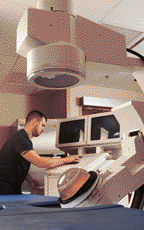|
More than 600,000 Americans each year suffer from kidney stones, a painful condition
marked by a sudden, sharp and severe pain in the back and/or abdomen. Kidneys perform
the function of a filter in the body, dissolving chemicals through a filtration
process and excreting waste in the form of urine. However, certain chemicals can
build up within the kidney, thus forming a stone. The signs and symptoms that are
experienced are determined by the location, size and shape of the kidney stone.
AKSM offers treatment of kidney stones through Extracorporeal Shockwave Lithotripsy
(ESWL).
What is ESWL?
Shockwaves, or high energy pressure waves, are produced outside the body using electromagnetic
or spark-gap technology. The waves travel through water and also through the body
without damaging living tissue. As they converge onto a hard kidney stone, the shockwaves
break the stone into small particles that can be passed in the urine.
ESWL is a non-invasive procedure requiring no incisions. It is less painful than
other surgical procedures used to treat kidney stones and requires a much shorter
recovery period. “Lithotripsy” is derived from the Greek words meaning
“stone crusher” and is performed on a lithotripter.
About the ESWL Procedure
We are committed to delivering an extraordinary level of patient service before,
during and after your procedure. Here is what you can expect:
- Before your treatment an intravenous (IV) line will be inserted, and during your
treatment medications will be administered through this line to keep you as comfortable
as possible. An X-ray (fluoroscopy) will be taken to make certain that your kidney
stone is in a treatable position.
- If your stone has moved or is not in a treatable position, your urologist may decide
that it is necessary for you to have an additional procedure (cystoscopy) to coax
the stone into a treatable position.
- During your treatment, our staff will position you on a flat table and, with the
use of fluoroscopy, will be able to visualize your stone for treatment. Monitors
also will be connected so that we can assess the progress of your treatment.
- Your urologist will be performing your treatment which lasts about 30 minutes. During
this period you will be made comfortable by attending anesthesia personnel.
- After treatment, most patients return to their normal activities within 24 hours
of treatment. Your urologist will be able to tell you when you may return to work.
- Following treatment, you may experience mild abdominal discomfort and/or develop
bruising or redness on your skin at the treatment site. You will have bloody urine
for the first few days after treatment. This is to be expected and should not be
a cause for alarm.
- While urinating, you may pass some stone particles and may continue to do so for
several weeks. It is important for you to collect these particles in the container
we will provide to you so that you may take them to your next appointment with your
urologist. It is important that you see your urologist for a follow-up visit.
|
